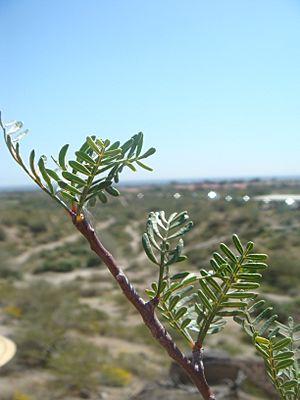Elephant tree facts for kids
Quick facts for kids Elephant tree |
|
|---|---|
 |
|
| Scientific classification | |
| Genus: |
Bursera
|
| Species: |
microphylla
|
 |
|
| Natural range of Bursera microphylla | |
| Synonyms | |
|
|
The elephant tree, also known as Bursera microphylla, is a unique tree found in the deserts of the southwestern United States and northwestern Mexico. It gets its English name from its thick, swollen trunk, which looks a bit like an elephant's leg! This special trunk helps the tree store water, allowing it to survive in very dry places. In Spanish, it's called torote.
Contents
Where the Elephant Tree Lives
The elephant tree is the most northern type of its plant family (Burseraceae) in North America. It loves extremely dry desert areas. You can find it in the desert hills and mountains of northwest Sonora, Mexico.
This tree is native to many parts of northwestern Mexico. These include Baja California, Sonora, and Zacatecas. It also grows in the southwestern United States. This includes southern California and Arizona, especially in desert regions.
You can spot elephant trees in many protected areas. Some examples are Organ Pipe Cactus National Monument and Anza-Borrego Desert State Park. A few trees grow in the Fish Creek Badlands of Anza-Borrego Desert State Park. This small group marks the northernmost place where this tree grows.
What the Elephant Tree Looks Like
The Bursera microphylla is usually a small tree. It has a very thick trunk and smaller branches. It is like a semi-succulent plant. This means it stores water in its trunk and lower branches. This helps it survive in dry places.
The tree can grow up to 10 meters (about 33 feet) tall. Its bark is light gray to white. Younger branches often have a reddish color. The leaves are light green and look like long, flat pods. They are made up of small, paired leaflets.
Flowers and Fruit
The elephant tree produces rounded yellow buds. These buds open into small, star-shaped flowers. The flowers are usually white or cream-colored.
The fruit is a small, round fruit called a drupe. It contains a single yellow seed inside. The fruits grow quickly and ripen slowly. Some fruits might even stay on the tree when new flowers start to grow the next summer.
How it Survives the Desert
Most trees in this family lose their leaves during dry times. But the elephant tree usually keeps its leaves all year. It only drops them if the weather is very dry or cold.
Most elephant trees flower in June and July. This happens just before or as their new leaves appear. This timing helps them use the summer monsoon rains.
How Seeds Spread
Birds are very important for spreading the elephant tree's seeds. Birds like Gray Vireos and Ash-throated Flycatchers eat the ripe fruits. They then help spread the seeds to new places. The areas where Gray Vireos live in winter often match where the elephant tree grows.
Birds do not seem to eat the unripe fruit. Sometimes, rodents gather the fruits and seeds. Ants have also been seen carrying away the seeds. The papery bark of some Bursera trees might even attract birds. It rustles in the wind, catching their attention from far away.
How People Use Elephant Trees
- The Cahuilla Native American people used the red sap from the elephant tree. They used it to treat skin problems and other illnesses.
- The Seri people use the wood from the elephant tree to make boxes.
- It is a popular plant for landscaping in the southwestern United States. People like to plant it in warm desert areas where it does not freeze.
Gallery
-
Bursera microphylla in Baja California, Mexico
-
Bursera microphylla in the Sonoran Desert, Arizona, U.S.
-
Bursera microphylla in the Vizcaino Desert, Baja California Sur, Mexico
See also
 In Spanish: Bursera microphylla para niños
In Spanish: Bursera microphylla para niños









